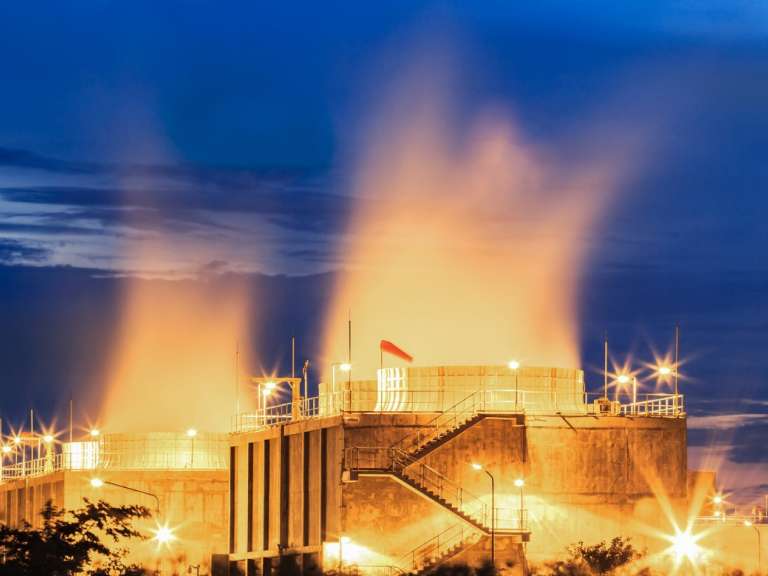Across the planet, water is becoming an increasingly scarce resource, and water availability is of critical importance to power plant operators in the US and elsewhere. Fortunately, gas-fired electricity generation technologies are becoming increasingly more resource efficient, requiring less water and fuel and producing fewer emissions. Air-cooled gas turbines are a good example of this trend, particularly with respect to water use.
Water scarcity is a problem and a challenge for two reasons. First, heated water is often released back into the water resource, affecting the aquatic environment. In some instances, this thermal pollution can cause generating plants to be shut down for extended periods. Second, a heavy reliance on water for cooling makes power-generating facilities extremely vulnerable to drought.
Texas Is Particularly Focused on Water Issues
This is especially true in areas like the US state of Texas that frequently experience severe drought conditions. Texas has been historically plagued by shortages of water, from a severe drought in the 1980s to two events in the 1990s, two more in the 2000s, and a crippling drought in 2011 that was only relieved by flooding and longer-term precipitation. According to The Texas Tribune, the 2011 drought was particularly bad, and authorities from the Electric Reliability Council of Texas identified several thousand megawatts of power plants that were at risk of not operating if the conditions had continued for several more months. The state is also looking at potentially having to shut down thousands of megawatts of coal plants, which could further reduce the amount of available generating capacity. Fortunately, the state was relieved by heavy rainfall, but that drought will certainly not be the last.
More Efficient Air-Cooled Turbines Can Make a Big Difference
As populations grow, water use grows, and the climate becomes increasingly unstable, water-related constraints to the power grid will increase. Fortunately, a new generation of high-efficiency, air-cooled gas turbines can help address this problem. The first of these units to be sold in the US have now been installed and tested in Texas in two separate 1,000-MW additions (of two 500-MW units each) to existing Exelon plants at Wolf Hollow and Colorado Bend. They will come online in 2017 and will help address the critical water availability issue in three ways.
The simple fact is that they are more efficient—boasting over 61 percent conversion efficiencies in a 60-herz combined cycle plant. This means that these turbines simply use less water per megawatt-hour generated compared to their less efficient brethren.
Then there's also the fact that these new plants have rapid ramping capabilities—up to 50 MW per minute (50 percent faster than previous generations)—and low turndown rates. They are simultaneously able to maintain compliance with emissions standards. This means that these plants are ideal for balancing increasing amounts of intermittent renewable resources. According to the American Wind Energy Association, Texas got 12.6 percent of its electricity from wind in 2016, with large amounts of wind and solar still in the development pipeline. Since wind and solar renewables don't rely on water, the more that can be added to the grid, the better it is for water supplies. Efficient and flexible air-cooled gas turbines can help complement these resources and thereby contribute to a more water-efficient power grid.
Efficiencies, faster ramp rates, and low turndowns help with water efficiency, but they are still mere drops in the bucket compared with the "killer app" of these new air-cooled gas turbines. That's because, instead of coming with traditional cooling towers, these turbines employ air-cooled condensers. Employing a direct dry cooling system that condenses exhaust steam inside air-cooled finned tubes, this technology cuts water consumption by 90 percent, reducing it by literally millions of gallons per day.
Water Efficiency Is a Critical Attribute in Local Acceptance of Power Plants
Such efficiencies matter in areas where water is scarce, and they can mean the difference between acceptance or rejection of new power generating resources. Exelon's Wolf Hollow Plant is located in Granbury, Texas, a community where serious droughts affected a large, nearby laken that is critical to the local tourism industry and is used extensively for recreation. To address Granbury's water concerns and win acceptance for the project, Exelon made the necessary investments to deploy a superior water-conserving technology.
Drought-stricken regions such as Texas are not the only places where water and power plants are becoming bones of contention. For example, Wicked Local reports that the proposal of another US project, a 350-MW gas-fired plant outside of Boston, Massachusetts, has resulted in a bitter and protracted battle with lawsuits among city officials concerning water availability for cooling.
As our climate continues to change and the demand on water inevitably increases, the conversation concerning the energy–water nexus is likely to intensify. Society will continually have to find ways to make its power grids less water-intensive. Highly efficient, air-cooled gas turbines will be a very useful tool in addressing these concerns, and will likely become a frequent fixture in the future power generation landscape.
